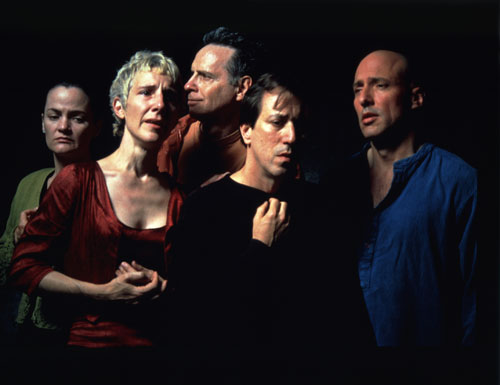Blain|Southern, London
9 February–26 March 2011
by SOPHIE ARKETTE
Part of what motivates him to produce this current series of work, as with the other works of a similar genre such as The Quintet of the Silent and The Quintet of Remembrance, is the notion that a film can be viewed as a temporally extended painting. What this involves is Viola selecting an historical image, a religious icon, or a re-enactment of some Christian episode in a painting, such as the Passion, and to use certain features of the work, an arrangement of figures or a strong use of light, as in a Carravaggio, such that the objects and people take on a sculptural quality, and to adapt these features to the filmic image. The transformation from painterly image to filmic image need not be that great if 300 frames a second, rather than the usual 14, are used. This enables the movement of the actors to be so smooth and slow as to be almost imperceptible. This is what is achieved in the Quintet of the Unseen.

Bill Viola. The Quintet of the Unseen, 2000 (production still). Video installation, colour video rear projection on screen mounted on wall. Projected image size: 140 x 240 cm. Photo: Kira Perov.
Of Samuel Beckett’s plays, the later ones are notable for their sparseness, for their brevity of dialogue and for their attention to detail: the subtle use of stage lighting or the precision by which Beckett instructed the actors, for example, in the raising of an arm or in the synchronous breathing in relation to the increased intensity or diminution of light, in the choreography of stillness and the use of the pause in a monologue, or the use of vocal inflection. The last of these is perhaps the most exacting, since Beckett by all accounts, was insistent that the voice should be colourless; an ashen voice was the description he favoured.
In reading through several of the plays, including the stage directions, one sees that Beckett had a particular liking for the barely perceptible: the sounds that are just above the cusp of audibility, the faint sound of the sea or of voices. Or objects bathed in diffused light, a faint outline of some stage props, a couple of urns cast in a shadow of darkness, as is directed in Play. Absence, too, is not unfamiliar to Beckett’s work, and he would often incorporate long stretches of darkness or silence as a way of accentuating the material economy of the set. In Not I the only point of reference to which one can attend is the movement of a mouth. It is the only part of the actor’s body to be lit, which thereby forces the audience to attend to the production of speech and to the speech act itself. So too Beckett’s choreography is marked by subtle changes of action, of a gaze in the distance being punctuated by a blink, of the motion involved in a rocking chair, or the equal tempered footfall as the actor paces back and forth across the stage.
In The Quintet of the Unseen, five figures are seen gazing in slightly different directions towards some off-camera focal point. They are motionless. After a time of watching and waiting, a slight movement – or an after-effect of some movement – is noticeable, such as a difference in the cast of a shadow. The viewer (audience) sees a figure move but rarely is the movement noticeable outside one’s attention; the action is only noticed as a change, as something already accomplished. To attend is to see, for example, the hand of one of the actors, over a period of five minutes or more, move up his arm and change from a fist to a grip; or on other occasions, the lowering and raising of an eye-lid or the transformation between a smile and a grimace, the change in a person’s focal point from the near distance to the far distance, or the opening and shutting of a mouth.
For Viola, part of what is involved in referring to a work of art, in particular to Renaissance paintings depicting religious scenes, is to recreate the facial and bodily expressions assumed by the figures in those compositions. The expressions of these figures are almost always exaggerated and stylised, as if to convey the archetypal expressions of sorrow, joy, compassion, love; and it is this aspect of depiction that Viola has tried to develop in his own work. Often referring to books on facial expressions and hand gestures, as when he credits the Chirologia or the natural language of the hand (1644), Viola has the actor perform these intricate gestures and displays of emotion. Their role throughout this film is to make the transformation between one and the next expression apparent and to depict it in such a way as to furnish the viewer with the idea that he is engaged in watching a painting unfold.